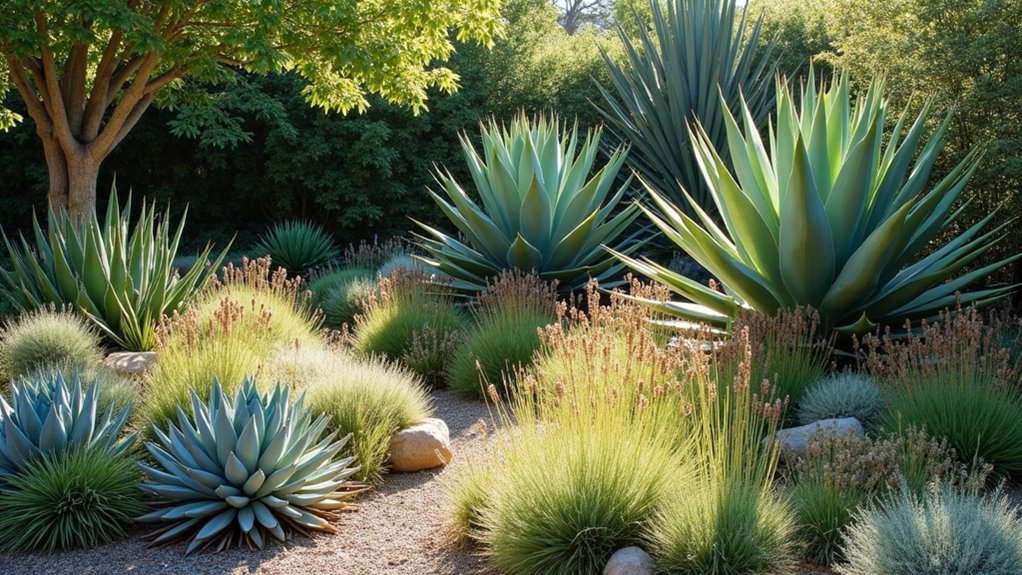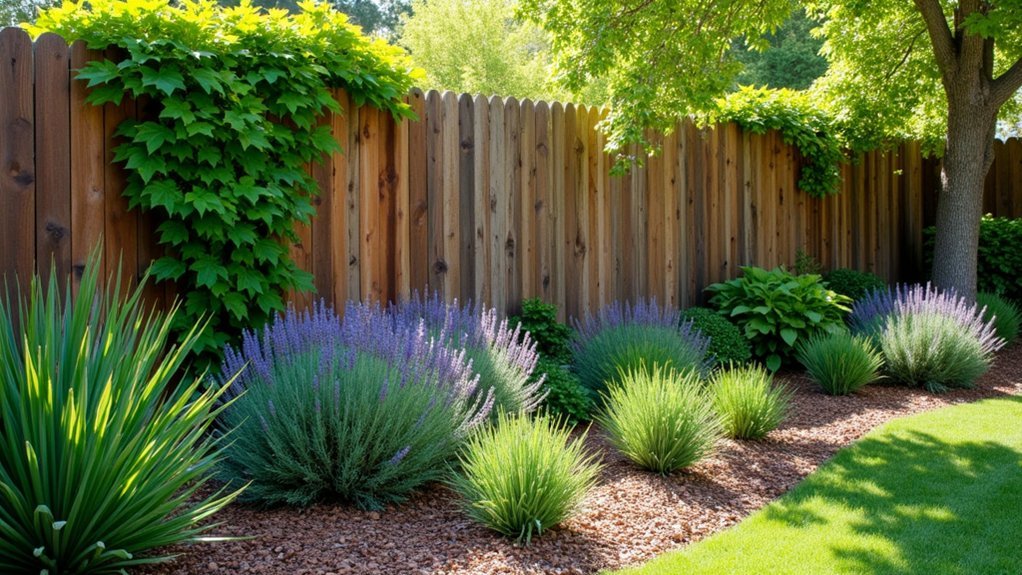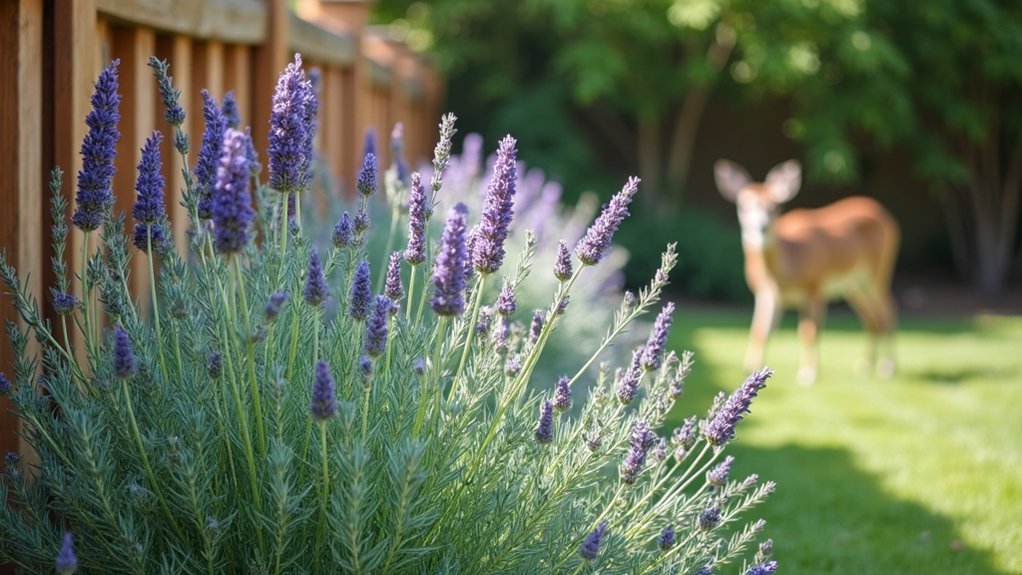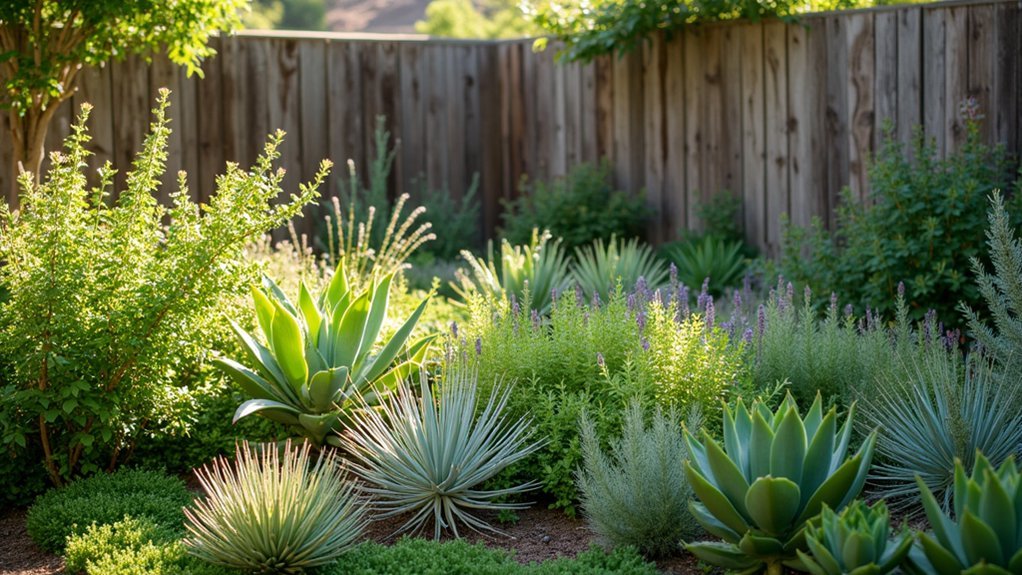Drought-tolerant plants for deer-proof fencing offer a double benefit: they thrive with minimal water while naturally deterring deer with their aromatic oils, tough textures, or thorny defenses. You’ll save time and resources by choosing options like Texas Sage, Lantana, Yucca, and Rosemary that require little maintenance once established. These plants create an effective barrier that supports local ecosystems, stabilizes soil, and attracts beneficial pollinators. Discover how these resilient choices can transform your landscape into a self-sustaining protective boundary.
Benefits of Combining Drought Resistance With Deer Deterrence

While creating a beautiful garden requires careful planning in any environment, those living in water-restricted areas with high deer populations face a unique challenge.
By selecting plants that are both drought tolerant and deer resistant, you’ll create a sustainable landscape that thrives with minimal intervention.
Smart gardeners choose plants that thirst less and deer avoid, creating effortless beauty that sustains itself.
Native plants that possess these dual characteristics often feature aromatic oils or tough textures that naturally deter deer while requiring less water.
This strategic approach helps reduce damage to your garden investment and dramatically cuts maintenance time.
You’ll also discover these hardy species frequently perform well in poor soils, creating visual interest throughout seasons without chemical deterrents.
The combination not only preserves precious water resources but attracts beneficial insects and pollinators, establishing a resilient ecosystem that remains beautiful despite challenging conditions.
Top Drought-Tolerant Shrubs That Deer Avoid
When designing a deer-resistant landscape that can withstand dry conditions, selecting the right shrubs forms the foundation of your strategy. Texas Sage offers both resilience and deer-deterring fragrant foliage, making it a top choice for arid gardens.
You’ll find Lantana equally effective—its hardy nature and rough texture prove unappealing to deer while adding vibrant color to your landscape.
For dramatic visual appeal, incorporate Yucca with its distinctive spiky leaves that naturally repel browsing deer.
Don’t overlook Rosemary, which serves double duty as a culinary herb and deer deterrent thanks to its potent aroma.
Creating a Living Barrier: Layering Techniques for Maximum Protection

Creating an effective deer barrier starts with strategic planting patterns that combine different drought-tolerant species in deliberate arrangements.
You’ll want to position taller, denser plants like boxwood or juniper as your outer defense, while filling gaps with medium-height options such as lavender and salvia.
Strategic Planting Patterns
To establish an effective deer barrier without traditional fencing, thoughtful layering of drought-tolerant plants becomes your secret weapon.
Position taller deer-resistant plants like butterfly bush or spirea at the back, creating a visual barrier that shields lower-growing varieties in front.
You’ll maximize protection by arranging plants in dense clusters, using strategic planting patterns that combine different textures and scents.
Incorporate rough-leaved juniper alongside fragrant lavender and Russian sage to create confusion for approaching deer. These drought-tolerant species not only deter browsing but also promote biodiversity in your garden.
For the most effective layered planting design, select varieties with staggered bloom times. This guarantees your garden maintains year-round interest while consistently presenting obstacles to curious deer.
Native species work particularly well, offering both resilience and ecological benefits.
Combining Heights Effectively
Successful deer-proofing through plant barriers depends entirely on strategic height combinations that create both physical and psychological deterrents. By combining heights effectively in your deer-resistant gardening, you’ll not only block deer access but also create a stunning visual barrier that enhances your garden design.
| Layer | Height | Recommended Plants |
|---|---|---|
| Back | Tall (4-6 ft) | Boxwood, Juniper, Butterfly Bush |
| Middle | Medium (2-4 ft) | Lavender, Salvia, Rosemary |
| Front | Low (1-2 ft) | Floss Flowers, Russian Sage |
| Ground | Under 1 ft | Japanese Pachysandra, Creeping Thyme |
| Accent | Varied | Ornamental Grasses, Yarrow |
Implement a tiered approach with taller deer-resistant plants at the perimeter, gradually decreasing height toward the interior. This layering technique creates an impenetrable structure that deer avoid while strong-scented varieties enhance the effectiveness of your living barrier.
Native Options for Water-Wise Deer Barriers
While many gardeners struggle with the dual challenges of water conservation and deer browsing, native drought-tolerant plants offer an elegant solution to both problems.
Texas Sage and Lantana create effective deer barriers while requiring minimal water and maintenance. These native options thrive where other plants fail.
Resilient and deer-resistant, Texas Sage and Lantana flourish with minimal care where less adaptive species struggle to survive.
You’ll find that Yucca and Salvia grow vigorously even in poor soil, forming dense plantings that naturally deter deer.
Most deer-resistant native species possess strong scents or tough textures that repel browsing without chemicals.
By incorporating Purple Coneflower and Butterfly Milkweed into your sustainable garden, you’ll not only block deer but also support local pollinators and wildlife.
Choosing plants that serve this dual purpose guarantees your landscape remains beautiful and resilient despite water restrictions and deer pressure.
Establishing Your Drought-Resistant Living Fence

You’ll need to carefully select plants based on your local climate and soil conditions, prioritizing species with complementary growth habits for an effective deer barrier.
When installing your living fence, stagger plantings in double rows and space them according to mature size to create a dense, impenetrable boundary.
Your maintenance commitment will be minimal after establishment, requiring just seasonal pruning and occasional deep watering during extended dry periods.
Plant Selection Strategies
Creating an effective deer-proof living fence begins with strategic plant selection that balances drought tolerance with deer resistance. When choosing plants, focus on native species like Purple Coneflower and Texas Sage that naturally withstand local drought conditions while deterring deer with their textures and scents.
- Layer your plants strategically – Position taller barrier plants like Junipers or Butterfly Bushes at the back, with medium and low-growing varieties in front to create a dense, impenetrable boundary.
- Incorporate diverse textures and scents – Mix fragrant options like Lavender and Salvia with rough-textured plants that deer find unpalatable.
- Consider growth patterns – Space plants according to their mature size, ensuring they’ll form an interconnected barrier that supports pollinators while maintaining visual appeal throughout seasons.
Installation Best Practices
Since proper installation directly impacts long-term success, establishing your drought-resistant living fence requires careful planning and execution. Begin by preparing your soil with organic matter to improve drainage and support healthy root development. Space your native plants according to their mature size to create an effective deer deterrent.
| Task | Best Practice |
|---|---|
| Soil Preparation | Mix in compost to improve drainage and nutrient content |
| Plant Selection | Choose native, drought-resistant species like Texas Sage |
| Spacing | Allow room for mature growth to create dense barriers |
| Layering | Combine tall and short plants for visual appeal |
| Maintenance | Water deeply but infrequently during establishment |
For maximum effectiveness, create a layered design with varying heights and textures. While your fence establishes, consistent maintenance including strategic pruning will encourage dense growth patterns that deter deer while enhancing your landscape’s beauty.
Maintenance Time Requirements
While many homeowners worry about the time commitment of a living fence, drought-resistant varieties considerably reduce your maintenance burden compared to traditional hedges.
Drought-tolerant plants require less attention once established, allowing you to maintain a healthy and effective barrier with minimal intervention.
- Most drought-tolerant plants need watering only during their establishment phase (typically the first growing season), after which they’ll thrive with rainfall alone.
- A diverse array of drought-resistant species creates a self-sustaining ecosystem that adapts to local conditions, further reducing your maintenance requirements.
- Simple seasonal care—occasional pruning and yearly mulching—is usually sufficient to keep your living fence vibrant.
Seasonal Maintenance Tips for Deer-Resistant Plantings

Even the hardiest drought-tolerant, deer-resistant plants need proper care to thrive throughout the changing seasons. Your maintenance routine should adapt to changing weather conditions to guarantee peak plant health.
| Season | Maintenance Tasks |
|---|---|
| Spring | Apply compost around plants to boost soil nutrients and fuel growth during this active period. |
| Summer | Practice deep, targeted watering to reach root zones without causing rot in your drought-tolerant specimens. |
| Fall | Remove dead foliage and apply mulch to insulate roots from winter temperatures while retaining moisture. |
| Winter | Regularly inspect for deer damage and adjust deterrent strategies as needed. |
Don’t forget to monitor weather patterns, especially during extended dry spells when even drought-tolerant plants might need supplemental watering. Your attentiveness to seasonal needs will reward you with vibrant, deer-resistant landscaping year-round.
Thorny Varieties That Thrive in Dry Conditions
Nature offers some of the best defenses against deer through thorny plants that also excel in drought conditions.
These thorny varieties create an effective natural barrier while requiring minimal water, making them perfect for deer-proof fencing in arid landscapes.
- Yucca and Barberry – Their sharp spines actively discourage deer from approaching your garden while thriving with limited irrigation in dry environments.
- Agave and Cacti – These drought-tolerant plants combine formidable thorns with striking architectural shapes, creating both protection and visual interest.
- Blackthorn and Thorny Olive – These versatile options offer excellent deer resistance while surviving with minimal water requirements, reducing your maintenance needs compared to traditional fencing materials.
Aromatic Plants That Naturally Repel Deer

Beyond physical barriers, aromatic plants offer a clever strategy for deer-proofing your landscape without sacrificing drought tolerance. You’ll find these fragrant species create sensory barriers that protect vulnerable plants while enhancing your garden’s beauty.
Many herbs emit strong fragrances that deer find repulsive, making them excellent natural repellents. When incorporated into your deer-proof fencing design, these plants serve dual purposes: deterring unwanted visitors and attracting beneficial pollinators.
| Plant Type | Repelling Mechanism | Additional Benefits |
|---|---|---|
| Lavender/Rosemary | Strong fragrance | Drought resistant |
| Catmint/Bee Balm | Minty scent | Attracts pollinators |
| Sage/Thyme | Bitter taste | Culinary uses |
| Yarrow/Anise Hyssop | Pungent aroma | Low maintenance |
Consider planting these aromatic deterrents strategically around your fence line for maximum effectiveness.
Designing an Aesthetically Pleasing Deer Barrier
Integrating natural beauty with function, you’ll find that drought-tolerant plants transform a utilitarian deer fence into an attractive landscape feature.
Your design can incorporate layered planting strategies, placing taller specimens like Butterfly Bush behind shorter colorful varieties such as Bee Balm and Signet Marigold.
Natural Beauty Meets Function
Many homeowners face the challenge of creating deer barriers that don’t transform their landscapes into fortress-like environments.
By incorporating drought-tolerant, deer-resistant plants, you’re achieving both protection and natural beauty in one thoughtful design.
Strategic placement of plants with strong scents like Lavender and Rosemary creates an effective deterrent while enhancing your garden’s sensory experience.
The vibrant blooms of perennials such as Bee Balm and Russian Sage attract beneficial insects while discouraging deer visits.
Consider these winning combinations:
- Texas Sage paired with Lantana for year-round texture and seasonal color
- Boxwood and Juniper for structural elements that create living boundaries
- Russian Sage and Bee Balm for height variation and pollinator attraction
Your garden design can seamlessly blend protection with beauty, creating a landscape that’s as functional as it’s attractive.
Layered Planting Strategies
When designing a deer-resistant garden, effective layering transforms a simple barrier into a stunning visual display. You’ll want to position taller plants like Junipers or Boxwoods at the back, creating your foundation.
In front, place shorter perennials such as Catmint or Lavender to soften the look and attract pollinators. This layered planting strategy serves as both visual barrier and physical deterrent against deer while promoting biodiversity in your garden.
Incorporate drought-tolerant, deer-resistant plants like Butterfly Bush and Salvia to enhance resilience during dry periods. For year-round interest, mix evergreen species such as Texas Sage with seasonal bloomers.
You’re not just keeping deer out—you’re creating a dynamic landscape that supports beneficial insects while maintaining an attractive boundary that performs beautifully in challenging conditions.
Color Throughout Seasons
Vibrant colors transform a simple deer barrier into a dynamic visual feast that changes with the seasons.
By incorporating drought-tolerant plants like Purple Coneflower and Butterfly Weed, you’ll create a barrier that’s both beautiful and resilient while attracting essential pollinators.
Strategically selecting seasonally blooming deer-resistant plants guarantees continuous visual interest from spring through fall:
- Layer tall Snapdragons behind low-growing Floss Flowers to create depth and color contrast that enhances your fencing’s aesthetic appeal.
- Include multi-seasonal performers like Yarrow that offer summer blooms and attractive fall foliage.
- Mix Russian Sage’s purple spires with the bright orange of Butterfly Weed for striking color combinations that remain vibrant even during dry periods.
Companion Planting Strategies for Enhanced Protection
Strategic companion planting offers gardeners a powerful tool to enhance their deer-resistant landscaping while maintaining drought tolerance. By pairing aromatic herbs like rosemary and lavender with vulnerable plants, you’ll mask their scent from deer browsing. Incorporating garlic or onions creates natural boundaries that deer avoid.
| Companion Plant | Benefits | Best Paired With |
|---|---|---|
| Rosemary | Masks scent, drought-tolerant | Roses, vegetables |
| Lavender | Deters deer, attracts pollinators | Perennials, edibles |
| Garlic | Creates pungent barrier | Fruit trees, tulips |
| Onions | Confuses deer’s sense of smell | Vegetables, flowers |
Your deer-proof fencing becomes more effective when you layer deer-resistant perennials like Bee Balm and Salvia with varying heights and textures. This diverse garden approach not only adds visual interest but also confuses deer, making your drought-tolerant landscape more resilient against browsing.
Water Conservation Methods for Your Living Fence
Establishing a water-efficient living fence requires thoughtful planning beyond simply selecting drought-tolerant plants.
Your fence can become a model of water conservation while still deterring deer effectively. Native species not only support local ecosystems but require considerably less irrigation once established.
- Apply a 2-3 inch layer of mulch around your plants to reduce soil evaporation, maintain soil moisture, and suppress water-stealing weeds.
- Install a drip irrigation system that delivers water directly to plant roots, minimizing waste and ensuring deep watering that encourages drought-resistance.
- Group plants with similar water needs together in your fence design, creating hydrozones that prevent overwatering and lower your water bills.
These sustainable gardening practices will help your deer-proof living fence thrive even during water restrictions.
Long-Term Success: Adapting Your Barrier to Changing Conditions
As our climate continues to shift, your deer-proof living fence must evolve to withstand new challenges. Drought-tolerant plants offer an adaptive solution with their deep root systems that stabilize soil and protect your fence’s structural integrity over time.
By selecting species that are adapted to local conditions, you’ll create a barrier that requires less water while maintaining effectiveness against deer. These sustainable choices reduce the need for constant irrigation—particularly valuable during extended dry periods.
Incorporate a diverse range of drought-tolerant plants to enhance biodiversity and build resilience in your garden ecosystem. This approach not only deters deer but creates a dynamic barrier that responds naturally to seasonal and climate variations.
Your living fence will remain vibrant and functional while conserving resources, offering long-term protection with minimal environmental impact.
Frequently Asked Questions
Do Deer-Resistant Plants Work?
Yes, deer-resistant plants work, but they’re not foolproof. You’ll find they deter deer when other food is available, but extremely hungry deer may still eat them. A diverse selection improves your protection.
What Is the Most Effective Method of Preventing Deer Damage in a Landscape?
Installing physical barriers, particularly fencing at least eight feet tall, is your most effective defense against deer damage. This method creates a reliable boundary that deer can’t easily jump over or breach.
What Plants Do Deer Hate the Most?
Deer most strongly avoid plants with potent scents like lavender and rosemary, bitter tastes like yarrow and garlic, and tough textures like yucca and barberry. You’ll find they’ll steer clear of marigolds and sage too.
What Is the Best Deer-Resistant Ground Cover?
Japanese Pachysandra is your best deer-resistant ground cover for shady areas, while Creeping Thyme works well in sunny spots. Both provide reliable coverage, and you’ll appreciate their low maintenance and deer-deterring properties.
In Summary
By selecting drought-tolerant, deer-resistant plants for your living fence, you’ll create a sustainable barrier that thrives with minimal water while keeping deer at bay. You’ve learned which species work best, how to layer them effectively, and ways to maintain their beauty over time. As climate patterns shift, your water-wise deer barrier will continue protecting your property while conserving precious resources—a smart solution for today’s environmental challenges.





Leave a Reply